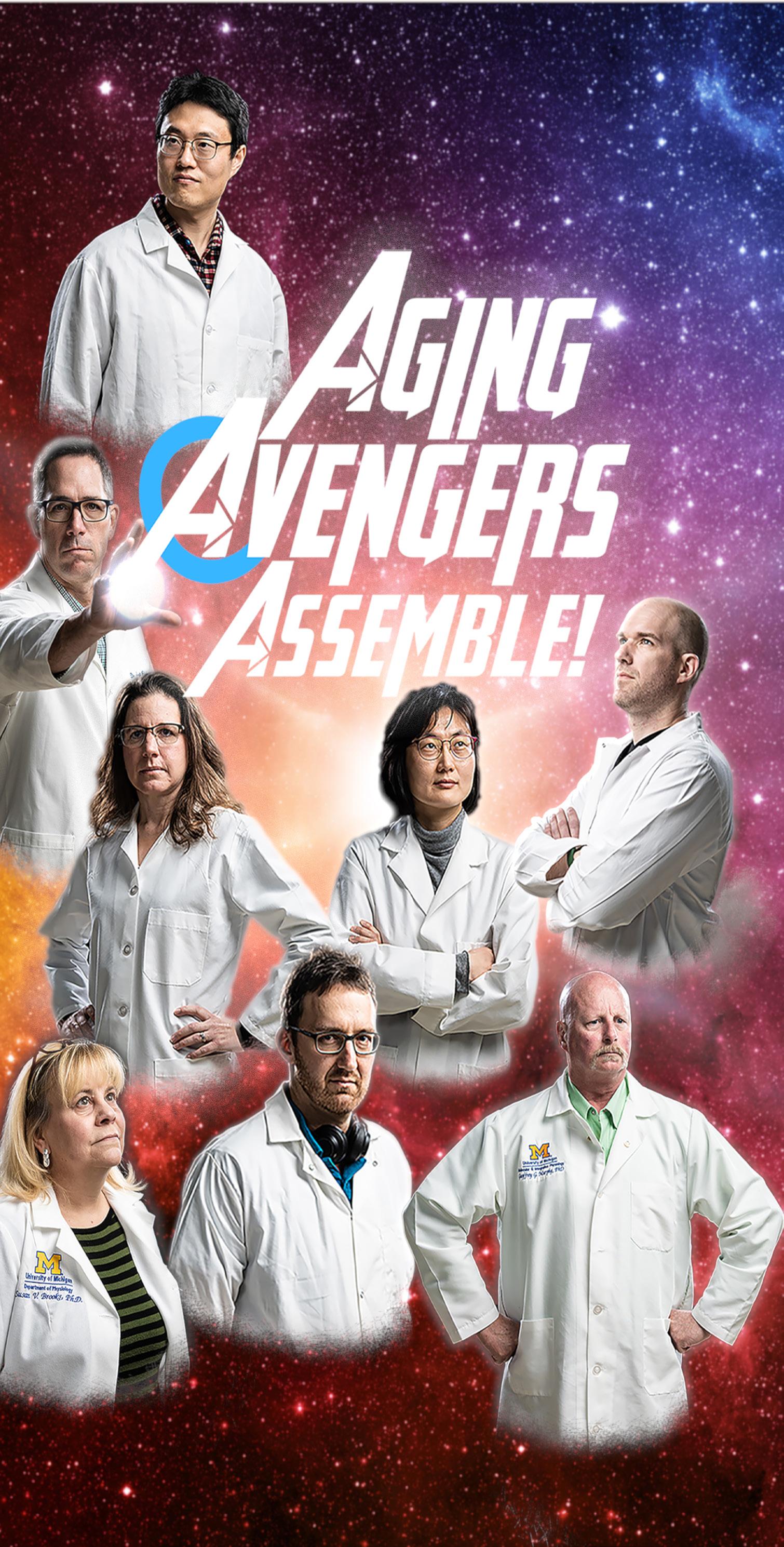
13 minute read
Battling the Scourge of Aging
For over half of a century, the Department of Molecular & Integrative Physiology (MIP) has partnered with the Geriatrics Center, the Division of Geriatric and Palliative Medicine, and the Institute of Gerontology to develop research and clinical communities devoted to defeating the evils of aging and the many forms that it may take. The faculty at the University of Michigan (UM) are now recognized as one of the finest in the world, for the study of the Biology of Aging. Consistently ranked in the top ten in research funding from the National Institute on Aging and in the quality of its primary care, UM is also home to several prestigious national centers and programs including the
Paul F. Glenn Center for Aging Research, the Claude D. Pepper
Older Americans Independence Center, and the NIH-funded
Career Training in the Biology of Aging program, which, for the past 35 years, has trained national leaders in aging research, medicine, and policy.
Nine primary MIP faculty members also hold appointments in the Geriatrics Center because major components of their research portfolios are devoted to unraveling the mysteries of aging. Recognizing that the complexity of aging is such that it is a foe that no single researcher can withstand, this closeknit, collaborative group loosed their superior intellect and unrivaled energy on understanding the basic mechanisms of aging and age-related disease. In 2019, the accomplishments of UM’s mightiest aging researchers, the Aging Avengers, have been featured in publications, conferences, classrooms, and public gatherings around the country.
The Aging Avengers’ achievements in this space are auspicious, as public and private interest in aging research is growing. The importance of aging as a risk factor for many diseases is now recognized across Institutes within the NIH. Industry is also taking notice. Well-established pharmaceutical companies, such as GSK and Novartis, have created new divisions focused on aging biology, and well-financed start-ups, often supported by highly-attractive parent companies (e.g., Calico-Google), are capturing the attention of the brightest young scientists.
Dr. Sue “She-Hulk” Brooks is interested in eliminating the breakdown of muscle function, termed sarcopenia, that occurs with advancing age. Drs. Myungjin “Captain Marvel” Kim, Jun Hee “Quicksilver” Lee, and Matthias “Thor” Truttman seek to better understand how our body’s innate stress responses can be co-opted to combat metabolic dysfunction, prevent the aggregation of mis-folded proteins, and extend healthy lifespan. Drs. Christi “The Wasp” Gendron, Scott “Mr. Fantastic” Leiser, Shawn “Vision” Xu, and Scott “Iron Man” Pletcher share interests in the role of the brain in controlling aging, at least in part through its ability to detect and respond to environmental conditions through sensory systems.
Together, we can all be comfortable in knowing that these super-scientists are working tirelessly to slow the pace of aging and to improve health at older ages, so that our children and all future generations are able to enjoy long, healthy lives.
Dr. Sue “She-Hulk” Brooks Despite clear success in rapidly building and maintaining muscle mass, She-Hulk recognizes that even super-heroes risk wasting and weakness during aging owing to the age-associated denervation and muscle fiber loss that appears inescapable. For normal people, gamma radiation is ineffective at promoting muscle health, so instead Dr. Brooks’ research targets the neuromuscular junction (NMJ), which is where motor neurons and muscle cells come together and where the signaling between them occurs that drives muscle movement. It turns out that large numbers of NMJs display structural abnormalities in old animals and old people, and these anomalies are observed in both the motor neurons, including increased branching and swelling, and at the muscle fiber membrane where dispersal of the receptors that receive neuronal signals occurs. In addition, with aging, substantial numbers of NMJs accumulate that have lost the critical overlap between the motor neurons and muscle membrane receptors. Whether motor neurons themselves are lost with age remains a controversial topic in the field, but progressive denervation is consistently seen late in life in rodents and humans, contributing to muscle weakness and muscle fiber loss.

In 2019, Dr. Brooks’ group focused on determining whether the critical events that initiate NMJ degeneration are happening in the neurons or in the muscle. Their group created genetically engineered mice in which the balance of reactive oxygen species, which can trigger oxidative stress that influences many biological processes, was altered specifically in either the motor neurons or muscle cells of the NMJ. They discovered that altered redox homeostasis in motor neurons triggers NMJ degeneration but alone is not sufficient to cause complete denervation. They also discovered that muscles of old animals are more likely than young muscles to be injured during normal contractions and that, following injury, regeneration is impaired. Dr. Brooks is currently testing the hypothesis that age-related muscle fiber denervation results from a breakdown in the remodeling of NMJs that occurs throughout the lifespan and whether this is compounded by cycles of injury and incomplete repair.
Drs. Christi “The Wasp” Gendron and Scott “Iron Man” Pletcher Like many of their superhero colleagues, Drs. Gendron and Pletcher recognize the power of sensory systems. Although we may intuitively appreciate that certain sensory experiences could be accompanied by deeper biological changes—the “fight or flight” response is triggered by the sense of danger and characterized by many physiological changes—Drs. Gendron and Pletcher have identified critical sensory structures and their functions that impact the aging process itself. By developing new technology to monitor neuron activity and behavior in fruit flies, they have shown that sensory neurons relate information about nutrition, danger, and conspecifics to initiate rapid changes health and aging. For example, exposure of Drosophila to the smell of food limits the beneficial effects of dietary restriction, while activation of “hunger” neurons mimics many effects of dietary restriction, including an increase in lifespan. Furthermore, the loss of specific neurons that mediate smell and taste also increase fly lifespan and physiology and influence measures of healthy aging, including sleep and daily activity patterns, and mere perception of the opposite sex modulates lifespan through neural circuits that establish motivation and reward. Ongoing studies indicate similar effects in mice.


In 2019, The Wasp and Tony Stark published their discovery that fruit flies exhibit significant changes in physiology and aging in response to the recognition of dead individuals in their environment. They pinpointed sight as the primary sensory mechanism through which this occurs, and they identified metabolomic changes in the brain as a result of the perceptive experience. The effects that they observed in flies are remarkably consistent with similar effects reported to be associated with psychological stress in humans, and they were reversed when flies were fed human drugs that target serotonin signaling. These results indicate deeply conserved mechanistic links between psychological and physical health, and they identify a candidate neural aging pathway through which the consequences of psychological effects manifest in humans.
people.

Dr. Scott “Mr. Fantastic” Leiser Like their natural ally, the Pletcher lab/Stark Industries, the Leiser lab is interested in how perception of the environment affects animal physiology. However, unlike our collaborating friends, they take a multi-organism and multi-system approach to aging research. By studying the roundworm Caenorhabditis elegans, they use large-scale screens and genetic engineering to manipulate animals and understand genes and processes that are important for promoting health and longevity. They then study conserved genes of interest in cell culture models, looking for conserved function of the genes in cellular processes. Finally, they use studies in mice to validate questions pertaining to the importance of genes, drugs, and/or biological processes that affect aging. Importantly, their research is not unidirectional, meaning that they seek to translate findings across organisms, making their data much more likely to be applicable to
In 2019, their nascent laboratory focused their investigative powers on the perception and response to stress and how this response relates to changes in healthspan and longevity. In the course of this work, Mr. Fantastic and colleagues mapped key circuits that control how animals sense food and oxygen and how they react to deprivation of these key metabolic components. These studies, as yet unpublished, revealed that both serotonin and dopamine signaling are crucial for one or both of these responses, and that there are drugs available with the potential to mimic life-extending interventions like dietary restriction. Dr. Lesier’s group also observed that the key changes in these stresses involve changes in proteins that control metabolism, providing a distinct mechanism for slowing the ravages of aging. As they continue to develop an understanding of both the perception and physiological changes that are associated with stress, the human race will inch ever closer to the development of future treatments that extend health and lifespan.
Drs. Myungjin “Captain Marvel” Kim and Jun Hee “Quicksilver” Lee Superheroes are always under stress to save the world. Too much stress is bad, but a little can be good, as it can help us focus on keeping everybody safe. It is the same for for normal humans. At the cellular level, too much environmental stress can be damaging to cells and tissues; however, a little bit of stress is known to activate adaptive mechanisms that prevent further stress-induced damage and that repair existing damage. It should be noted that fortifying these mechanisms not only improves stress resistance but also extends the health- and lifespan of an organism. Drs. Kim and Lee investigate these stress response mechanisms with the hopes of discovering new ways to tackle aging and to promote health and productivity later in life.

Specific types of everyday stress, such as that induced by endurance exercise, can also be beneficial for an organism’s health. Despite extensive studies, however, the molecular mechanisms underlying the benefits of exercise have remained elusive. Several recent studies indicated that exercise induces synthesis of a protein family named Sestrins. More recently, Captain Marvel and Quicksilver and their colleagues used experiments conducted in the fruit fly and the mouse to discover that a family or proteins, called Sestrins, are both necessary and sufficient for the metabolic benefits of exercise. Sestrin-deficient animals did not exhibit increases in endurance and metabolic fitness following exercise, while animals in which Sestrin was overexpressed experienced the metabolic benefits of exercise in the absence of exercise itself. Further research is currently being undertaken to identify how Sestrins are regulated and to identify drugs that may modulate their activity.


Dr. Matthias “Thor” Truttmann Dr. Truttmann and his laboratory study how a specific class of proteins, called molecular chaperones, control protein aggregation in the context of neurodegeneration and aging. In the past, Dr. Truttmann has used S. cerevisiae (Brewer’s Yeast) and C. elegans (a nematode worm) models in combination with biochemical approaches to define the impact of how a specific modification that is applied to proteins after they are formed, called AMPylation, modulates chaperone activity. He showed that increasing chaperone AMPylation alters the aggregation dynamics of disease-associated proteins such as amyloid beta and a-synuclein, two
proteins linked to the pathology of Alzheimer’s disease and Parkinson’s disease, respectively. Recent work indicates that these processes are conserved from worms to humans and may indeed impact protein aggregation in disease patients. Indeed, Dr. Truttmann believes that chaperones may be prime targets to intervene in and to control aging-associated protein aggregation processes.
Thor, who was granted his alter-ego because of his scientific training in the cold mountains of northern Europe, was the most recent hire of the Department of Molecular and Integrative Physiology. Since summer 2018, Thor has been swinging his hammer in Ann Arbor and has been devoted to recruiting a strong team to help him continue his scientific adventures, which focus on the crossroads between chaperone function, protein aggregation, and aging. Together with his team of super-women and -men, Thor established his new refugium, where he retreats to and discusses his newest scientific plans with his team members. It’s only a matter of time before their mighty work will be unveiled to the public and the man with the hammer returns.
Dr. Shawn “Vision” Xu As suggested by his moniker, Vision is interested in understanding how animals sense their external and internal world through sensory systems. Sensory cues, such as temperature, chemicals (odor and tastent), touch and light regulate not only an animal’s behavior, but also its physiology — such as aging and longevity. For example, both cold- and warm-blooded animals live longer at lower body temperatures, highlighting a general role of temperature in lifespan regulation. However, the underlying mechanisms remain largely unknown. Dr. Xu’s lab recently identified a cold-sensitive thermal sensor that detects temperature decreases in the environment to extend lifespan, demonstrating that genes actively promote longevity at cold temperatures. This calls into question the century-old view that cold-dependent lifespan extension is simply a passive thermodynamic process. Vision’s laboratory is now identifying new genes and pathways that mediate temperature- and chemical cue-dependent regulation of lifespan and healthspan in C. elegans. Ultimately, they would like to derive a thorough understanding of how sensory cues regulate aging and longevity.

Like Dr. Sue “She-Hulk” Brooks, Dr. Xu is also interested in understanding the mechanism of motor aging. As animals and humans age, the motor system undergoes a progressive functional decline, leading to frailty. Age-dependent functional deterioration at neuromuscular junctions (NMJs) contribute to this frailty. However, it is unclear whether one can intervene in this process to slow motor aging. In work published in 2019, Dr. Xu’s group reported that genetic ablation of a gene called SLO-1, which encodes a channel that normally functions to suppress the function of motor neurons, reduced the rate of agedependent motor activity decline and, surprisingly, extended nematode lifespan. Their results demonstrate that genetic and pharmacological interventions in the aging motor nervous system can promote both healthspan and lifespan.
Dr. Geoff “Dr. Strange” Murphy Dr. Strange and his lab study learning and memory. Specifically, the Murphy Lab is interested in a brain region known as the hippocampus; which is required for the encoding of long-term memories. Similar to the Time Stone within the Eye of Agamotto, the hippocampus allows humans to travel through time. If the hippocampus is damaged or becomes dysfunctional, humans lose the ability to encode new memories of people places and events, thus confining them to the present—which inevitably becomes the past. Dr. Murphy and his team are working to better understand how the hippocampus promotes the storage of long-term memories and how this process is disrupted during aging and in Alzheimer’s disease. The Murphy lab has recently genetically engineered a transgenic mouse which mimics the age-related increase in expression of an L-type calcium channel known as CaV1.3. Young CaV1.3 transgenic mice exhibit cognitive impairments and dysregulated neuronal calcium homeostasis, like that typically observed in aged mice. In collaboration with Daniel Lawrence in MIP, the Murphy lab is also working to better understand the cause of cerebrovascular derangements that are associated with Alzheimer’s disease and how the altered vasculature impacts neuronal function and cognition. Using a transgenic mouse model that expresses mutated proteins known to be altered in Alzheimer’s disease, the lab has developed a method for visualizing the entire brain vasculature which allows them to quantify blood vessel morphometry with ~1-micron resolution. Using this data, the team can mathematically model the changes in cerebral blood flow. The long-term goal is to develop drugs designed to ameliorate Alzheimer’s disease related vascular dysfunction.











